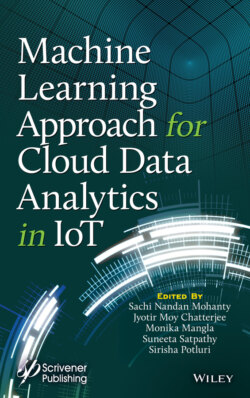Читать книгу Machine Learning Approach for Cloud Data Analytics in IoT - Группа авторов - Страница 48
2.2 Some Associated Impactful Terms 2.2.1 IoT
ОглавлениеIt can be enumerated in a sense of a sensible system of interrelated computing mediums along w ith association of electronic, mechanical, and digital machines that were built up with unique identifiers and its capability to get on over the network for transferring data without the intervention among the human beings as well as in between the users and computer.
It also can be noted as a perfect definition of a large range of globally connected devices of many forms starting from a sensor to that of smart phones and even beyond these.
The IoT has come up as the next revolutionary ideology [1], which enables billions of devices all over the world over a distributed network to be networked completely for transformation of data and its exchange, which would enhance the quality of our day-to-day lives. At the same time, cloud computing paves demand for convenient and stupendous network accessibility to enable sharing computing of resources possible in all aspects which would, in turn, make data integration dynamically from all the relative data sources in an adherent way. There exist various issues while implementing cloud and IoT, and the defragmentation of cloud computing with IoT is the one of the most purposeful ways, in which it needs to come over such issues. The wide range of resources available over the cloud can be effectively beneficial toward the cause of IoT, while the cloud can be profitable in gaining publicity to enhance its efficiency by coming over its shortcomings with the real-world objects in a versatile and distributed way. This study of ours provides an overview of integrating cloud and IoT over basing each other for a generous dealing with cybercrimes, thereby implementing the machine learning methodological algorithms over it in a procuring way.
IoT presents ubiquitous connectivity for a wide range of devices, services, and applications. These include intelligent computers, smart phones, office equipment, wireless-enabled cars, lighting systems, heating, ventilation, and air condition (HVAC), household appliances, and many others. To be IoT-enabled, a device (“thing”) ought to be on a network and connected to a communicating node. Various communication network technologies and their architectural infrastructures in a fully connected network such as 3G, LTE, Wi-Fi, Bluetooth, ZigBee, Z-wave, and Sigfox provide reinforced connectivity services for IoT deployment on many services platforms [2].
Over the past decade, internet technologies have revolutionized the interconnection among people at an unprecedented scale and pace. The next revolution is expected to craft the interconnection among diverse objects leading to what experts termed as the smart environment.
As we move from World Wide Web (static pages web) to web2 (social networking web) to web3 (ubiquitous computing or web of things), the need for data-on-demand using sophisticated intuitive queries continues to increase significantly. This era could be consequently termed as the post-PC era where smart phones and related devices are changing our environment and the way “thing” (including humans) interacts. Things in the new environment are becoming more interactive as well as informative in an operative manner.
